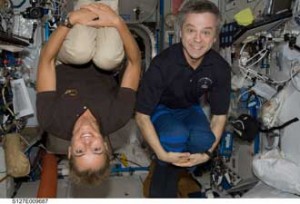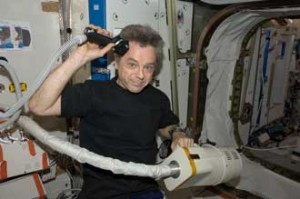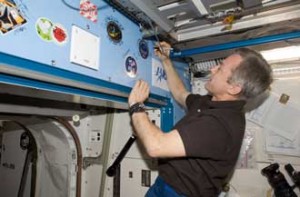
McGill grad Robert Thirsk (MD’82) is the first Canadian astronaut to take part in a long duration mission. By mission’s end, Thirsk will have lived on board the International Space Station for six months.
By Robert Thirsk
I haven’t driven a car in three months, and yet I’ve traveled 70 million kilometers. I’ve watched 16 sunrises and sunsets in a single day. I’ve sipped coffee out of a bag through a straw, and squeezed macaroni and cheese from a package into my mouth. I’ve conducted many scientific and medical experiments. I’ve welcomed extraterrestrial friends to my home and bid them farewell. I’ve helped repair a toilet, as well as a carbon dioxide scrubber, and an oxygen generator.
It’s all in a day’s work aboard the International Space Station (ISS). Today is Flight Day 100 and I am now more than halfway through my six month expedition. As a Canadian Space Agency astronaut, I have the privilege to live aboard the Station for a long duration expedition. I still pinch myself in disbelief as I contemplate my good fortune.
A lot has happened in 100 days. Let me share the highlights and some of the not-so-ordinary events of everyday life in space.
The beginning
My ISS adventure began in late May at the Soyuz rocket launch site in Baikonur, Kazakhstan. The training program leading up to launch had been arduous and took me away from home for weeks and months at a time. I was happy that my family was able to join me for the last three days of launch preparations. It seemed to me that each of my children had changed a bit since I last saw them. I refer to my wife and children as the diamonds in my backyard. Their strength, beauty, and sparkle energized me as I prepared for departure.
On May 27 I launched to orbit in the Russian Soyuz vehicle with my crewmates, Roman Romanenko and Frank De Winne. Lift off was smoother than I had expected with only the nominal jolting at rocket staging and when the engines finally shut down at the end of our 9 minute ascent. After two days in orbit, we rendezvoused and docked to our home for the next six months, the International Space Station.
I was the first to float through the hatch into the Space Station. My exhilaration was beyond words and the joy on my face has since been described in jest by my flight surgeon as “smilitis, for which there is no cure”. Entering the Station was like entering a Salvadore Dali painting. Ground-based simulators cannot possibly replicate those first surreal moments. And no preparation could restrain my elation at seeing our three new Station crewmates who welcomed us to our new home.
As I made my entrance into this new reality, my family watched from the Mission Control Centre in Moscow and shared in my happiness. My wife Brenda spoke to me on the space-to-ground voice channel and quoted an old Italian expression ‘in bocca al lupo’ for best wishes.

My crew
My five crewmates on the Station compensate somewhat for the natural desire to be with loved ones on Earth. They are wonderful people. We all had strong desires to be members of this expedition, and to use our skills to advance science and technology. It is a privilege to work with such individuals who have high aspirations and exceptional abilities.
Gennady Padalka and Roman Romanenko are from Russia, Mike Barratt and Tim Kopra are from the United States, and Frank De Winne is from Belgium. I represent Canada in this menagerie of cultures and languages. The international scope of our expedition is exemplary and sets the standard for future collaborations among nations.
We mostly speak English and Russian. Sometimes we start a sentence in one language and finish it in the other. Roman describes the mishmash language we speak as ‘Runglish.’
We all recognize how fortunate we are to be here. There is not a day that passes when one of us doesn’t stop and exclaim “I can’t believe we’re doing this!”
With the arrival of Roman, Frank and I to the Station, the ISS now hosts a permanent crew of six. This represents a significant milestone in the program. The Station has plenty of living space and the technical and psychological resources to support six people.
The psychosocial needs of the crew are addressed in a variety of ways. I especially enjoy the weekly videoconferences with my family. Brenda and the children sit in our living room at home as they speak to me. Occasionally our dog joins in, looking for a warm lap and someone to pet him. When I celebrated my birthday a couple of weeks ago, balloons decorated the background.
Our families also send care packages to us filled with treats, cards, music and things that we might miss during this long mission. Our respective space agencies uplink webpages and podcasts of our favourite radio and television shows. There is plenty to do when we are not working.
The Daily Routine
Our daily activities are scheduled according to Greenwich Mean Time. We wake up at 06:00 GMT and spend the next two hours performing personal hygiene activities, eating breakfast and preparing for our work day. Around 8 am we gather as a crew for the morning ‘Daily Planning Conference’ with each of the ISS mission control centres in Houston, Huntsville, Munich, Tsukuba and Moscow.
Our work day is typically 10 ½ hours long and includes two hours of exercise and an hour for lunch. While it may seem that our motions in weightlessness are slow and unhurried, the work pace is brisk and requires constant attention. I enjoy the varied tasks which include maintenance and repair of the Station’s systems and payloads.
Research is an important part of our work. Now that the Station is nearly complete and is staffed by a crew of six astronauts, we are able to perform a large number and wide variety of biological, medical, fluid physics, materials processing and technological investigations. During Expedition 20 alone, more than 100 experiments and over 1,000 hours of crew time is devoted to research. This is unprecedented.
Our evening ‘Daily Planning Conference’ ends our work day. We report accomplishments and discuss the next day’s work plan. This system keeps us on task and fosters readiness and productivity. It is a mission model that would certainly work well elsewhere on Earth with its emphasis on teamwork and regular discussions of process and outcome. I see managerial applications as well as pedagogical innovations.
Bedtime is also scheduled, and although we aim to be tucked into our sleeping bags by 9:30 pm, we usually break curfew in order to take care of our personal affairs, such as reading and writing e-mails to family and friends. I share stories with Aidan, our youngest son, who is a Boy Scout and passionate camper. He currently prefers a hammock in the open air over a sleeping bag. I tell him that a hammock would not work well in a weightless environment, as he would float out of it.
In the evenings, we prepare our notes and tools for the following day. Life on orbit mimics that on Earth. It is difficult to achieve all we set out to do in a single day. But every night I go to bed feeling fulfilled.
Weekends in space are similar to those on Earth. We catch up on sleep and housecleaning. We often volunteer to perform additional sessions of scientific experiments and to produce educational videos. We spend much time looking out windows at our beautiful planet. I am always excited to see my homeland, Canada, but from above one is able to see most of our planet as well in a single day. My appreciation for the landscape, colour and texture of every country has created a lasting mosaic in my mind. We take photographs for pleasure but also for scientists who benefit from our imagery of craters, hurricanes and regions of environmental concern.
Several Canadian experiments are being conducted aboard the Station. During the first few weeks of our expedition, an experiment by Dr. Lawrence Harris of York University on neuroperception produced some interesting findings. Additional runs have been requested. Dr. Masohiro Kawaji of the University of Toronto is collaborating with Yokohama National University to study Marangoni convection, a subtle form of fluid flow that cannot be well studied on Earth.
Other Canadian payloads will be delivered to the Station by the next two shuttle flights. I expect to be involved in activating and operating many of these experiments. I eagerly await their scientific results.
I am fond of scientific advancements that translate into practical applications on Earth. For instance, MacDonald Dettwiler and Associates, the company that built Canadarm2 and Dextre for the International Space Station, has partnered with the University of Calgary Medical School to develop a telerobotic microsurgical system called neuroArm. neuroArm incorporates space control systems and vision technology that allows surgeons to perform intricate microscopic neurosurgical procedures.
These kinds of benefits not only enhance the human experience of spaceflight, but also stimulate our youth’s desire for knowledge. My daughter, Lisane, recently volunteered in an orphanage in Mexico. She met a ten year old boy whose story of survival defies comprehension. Yet his curiosity about everything including space, and his passion for learning confirms the human need to explore and understand even in face of adversity. This strengthens my belief that the benefit of my work is not limited to developed nations but reaches to all parts of the world.
Adaptation
While the scope of space missions is international and far reaching, it is also important for astronauts to be attuned to our own physiology as subjects of medical experiments and for our own physical well-being. For instance, I’ve noted that my appearance has changed slightly. In weightlessness, there is a headward shift of body fluids that results in a slight rounding of my face and thinning of my legs. As a bonus, this shift has smoothed out the wrinkles around my eyes and on my forehead. My hair rises up off my head and my height has increased by four centimeters. When I’m relaxed in weightlessness, my body adopts a quasi-fetal posture. I need to keep stretching out my legs to prevent my hamstrings from tightening up.
Moving about in weightlessness is so effortless that many of my muscles and bones have been on vacation for three months! We use several fitness machines on the Space Station to stay in shape. When I run on the treadmill I wear a harness to hold myself onto the tread. The harness applies a downward force over my shoulders and around my hips that is equal to my body weight on Earth. This is a significant load for my deconditioned body and my hip joints complain loudly! It is only through mental determination that I overcome the discomfort and complete a half-hour run. My son Elliot enjoys his terrestrial advantage over me and he reminds me of my reduced muscle mass whenever we compare fitness levels.
Habitability
The International Space Station does not resemble the glossy, sanitized space stations that are sometimes depicted in science fiction movies. Our Station has more of a working appearance. The layout of cables, hoses and computers makes sense to me, but to a newcomer it must be bewildering.
The ISS is a technological wonder. It functions as a scientific laboratory, an engineering test-bed, an assembly base and a repair shop. Within the harsh environment of space, the Station sustains the six of us in comfortable living and working conditions. That’s incredible.
Seasoned expedition crewmembers move quickly about the Station. We don’t move so quickly, however, that we lose control and disrupt items stowed on the walls. Light touches here and there are all that is required to orient ourselves and stay on trajectory. Velcro, clips and duct tape are used to hold items down. Nevertheless, the loss of personal items and tools is a daily occurrence. They just seem to float away when we’re not looking.
We live without many comforts of modern life. There is no bath tub or shower on the Station, and we rarely eat fresh food. Clothing items get changed only after a week or two of wear. We wipe down our bodies each day with a washcloth. After wetting our hair with shampoo and working it through with our fingers, we dry our hair with a towel. Rinsing in weightlessness is not possible. There is no place to spit so we usually swallow our toothpaste after brushing. These inconveniences are a small price to pay for the exhilaration of living in space.
A lot of attention is paid to stowage, inventory and trash management. We are disciplined about re-stowing items back in their correct location. We make great efforts to conserve supplies as well as stowage space, a precious resource aboard a space station. One of the first skills I learned as a new Station crewmember was to crush used food cans absolutely flat so that they take up little volume in our trash bags. We recycle paper, ziplock bags and other supplies. The water vapour that we exhale into the cabin atmosphere as well as our waste water, sweat and urine is processed into pure drinking water.
Shuttle vs. Station
The extraterrestrial friends I referred to earlier were crewmembers of the space shuttle Endeavour which visited us in July and the crew of the shuttle Discovery which is presently docked to the Station. It was gratifying to see Julie Payette on orbit. Julie and I have worked and trained together in a variety of locales and situations. But this was the first time that two Canadians had worked together in orbit.
A Station astronaut functions differently than a shuttle astronaut. While shuttle crewmembers are task-oriented, Space Station astronauts are skills-oriented. It is impossible to precisely predict before the launch of a Space Station expedition what tasks we will need to perform. Therefore the focus of our training is more on the acquisition of generic skills and less on the performance of specific tasks. We need a broad and deep understanding of our Space Station systems and payloads, and the mindset to be ready for whatever may arise.
Failures happen. As is typical with every space mission, our expedition has experienced some minor troubles. The systems that scrub carbon dioxide out of our cabin atmosphere and provide breathing oxygen both failed recently and needed to be fixed. I never trained specifically to repair these systems, but I had the necessary skills to help fix them.

Halfway
Today is Flight Day 100. There remains much to accomplish during the last half of this expedition. The shuttle Discovery has arrived and is re-supplying us with consumables, spare parts, food and new scientific payloads. Discovery has also brought my crew quarters (I have been sleeping in a temporary sleep station within the Japanese Laboratory module until now) and a new Station crewmember, Nicole Stott. After the shuttle departs, the new Japanese cargo vehicle, HTV, will arrive. The capture and berthing of this enormous spacecraft with the Canadarm2 represent the most demanding aspects of this expedition for me and my crewmates.
The International Space Station is a remarkable place. Present day utilization of this world-class facility is only possible because of the ingenuity of its designers, the skills of its engineers, and the hard work of the previous crews who assembled it. I am privileged to benefit today from their contributions.
When I launched, I wasn’t exactly sure what six months in space would be like. After 100 days of spaceflight experience, I now feel like a veteran and am confident that I will do well during the remaining months. I’ve grown accustomed to the Station’s sounds, smells and rhythm of life. I will miss it when I eventually leave. It will be like moving away from a childhood home that is rich with family memories.
Six months is a long time to be separated from my family and everything familiar on Earth. I appreciate the words of encouragement sent to me by Canadians. Your words, prose, poetry, and photographs keep me in contact with Earth and make me feel supported.
I am pleased that Canada is involved in the International Space Station program and proud that we are regarded as a nation of explorers. The future is ours to venture further, to learn about our solar system and to discover more fully who we are.
This article first appeared on the Canadian Space Agency website on September 15, 2009
